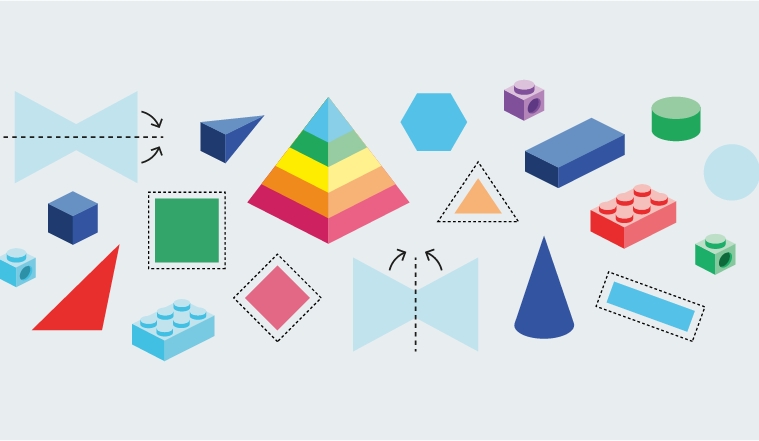
Qualification Course
Geometry and Spatial Reasoning
1 day
Duration
6 credits
Earned
This course is designed for primary school teachers who aspire to excel in teaching geometry to pupils from the Early Years Foundation Stage (EYFS) to Year 6. Intended for classroom educators and mathematics leads, the programme builds upon the foundational knowledge acquired in the Essentials of Teaching Maths Mastery course, with prior completion highly recommended.
Course Objectives
This professional development course focuses on teaching and learning in geometry and spatial reasoning:
- Mastering Fundamental Geometry and Spatial Reasoning: Provide teachers with effective strategies for introducing young learners to the basic concepts of shapes and spatial awareness, laying the groundwork for developing advanced geometric thinking and spatial reasoning skills.
- Understanding and Applying Geometric Properties: Enhance teachers' knowledge of the properties of 2D and 3D shapes, including how to measure and compare these shapes, enabling teachers to convey these concepts effectively for real-world problem-solving applications.
- Enhancing Spatial Reasoning and Problem Solving: Improve instructional methods for teaching transformations, symmetry, and geometric reasoning, aiming to foster students' abilities in visualisation, manipulation of shapes, and advanced spatial reasoning for complex geometric understanding.
- Understanding Technology and Differentiated Instruction: Introduce innovative digital tools and personalised teaching strategies to make geometry more accessible and engaging for all pupils, highlighting the importance of interactive learning and the adaptation of lessons to meet diverse learning needs.
Meeting these objectives will allow educators to support their students’ learning of geometry, fostering a deep understanding and curiosity of the subject.
Earn 6 credits
Course Content
- Shape Recognition and Properties: Begin with engaging activities that introduce young learners to the basic shapes, then progress to exploring the properties of 2D and 3D shapes using tangible manipulatives and visual aids. Emphasise the significance of understanding shapes' properties, such as angles, sides, and faces, to lay a solid foundation for spatial reasoning.
- Position, Direction, and Movement: Utilise practical activities and real-life scenarios to teach concepts of position, direction, and movement, including the use of compass directions, grid references, and coordinates. This section aims to develop precise language and conceptual understanding vital for spatial reasoning and navigation.
- Exploring 2D and 3D Shapes: Dive deeper into the distinctions and relationships between 2D and 3D shapes, focusing on their properties with hands-on experiences to enhance spatial understanding. Activities include constructing models, comparing shapes based on their properties, and understanding the concept of shape transformation in space.
- Measuring Shapes: Cover the basics of geometric measurement, including length, perimeter, area, volume, and angle measurement. Use real-life applications and practical activities to demonstrate the relevance and methods of measuring different geometric attributes, reinforcing the connection between geometry and the physical world.
- Symmetry and Transformations: Teach concepts of symmetry and geometric transformations, such as translation, rotation, and reflection, through a variety of engaging activities. These concepts will be explored using visual arts, interactive software, and hands-on manipulatives to help students visualise and understand geometric changes and symmetry in shapes.
- Geometric Reasoning and Problem Solving: Develop pupils' geometric reasoning and problem-solving skills through tasks that encourage them to apply their knowledge of shapes, properties, and measurements in new and unfamiliar contexts.
- Perimeter, Area, and Volume: Progress to teaching more complex concepts such as perimeter, area, and volume for upper primary levels, using practical examples and activities that link these concepts to real-life situations. This will help pupils understand how geometry applies to their everyday environment and encourages practical spatial reasoning.
- Technology Integration: Showcase how technology can be employed to teach geometry more effectively, using interactive geometry software, online resources, and apps that support visual and spatial learning. Highlight how these tools can create dynamic geometric explorations and facilitate understanding of abstract concepts.
- Differentiated Learning: Offer strategies for differentiating geometry instruction to cater to the diverse needs of pupils, ensuring that geometry lessons are inclusive, accessible, and engaging for students with varying levels of understanding and learning styles.
- Assessment and Feedback: Discuss effective assessment strategies and feedback mechanisms for geometry, helping teachers to monitor student progress and adjust their teaching methods accordingly. Include methods for using formative assessments, peer assessments, and self-assessments to provide comprehensive feedback and support learning.
Who this is course intended for?
Upcoming Dates
Stay tuned for more dates
Don’t see a date that suits your schedule?
Level up your practice
How It Works
Find out more about the different types of training we offer and whether it's right for you.
International Events
Can't make it to our face-to-face training events? Don't worry! We have several online offerings. To see what's available, go to our Event Calendar and filter for 'online' in the Events dropdown.
By clicking “Accept All”, you agree to the storing of cookies on your device to enhance site navigation, analyze site usage and assist in our marketing efforts.